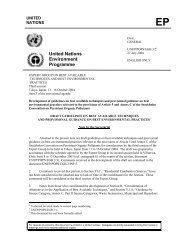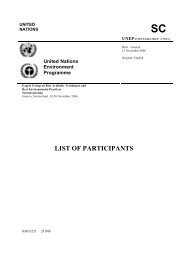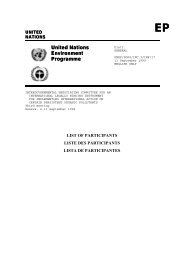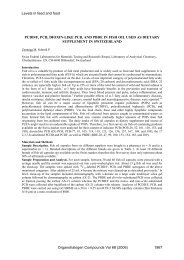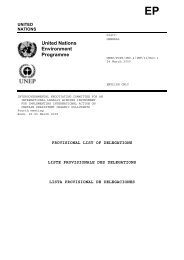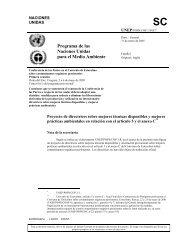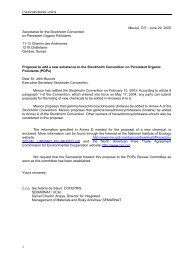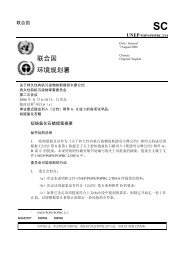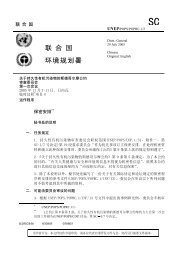United Nations Environment Programme - Stockholm Convention on ...
United Nations Environment Programme - Stockholm Convention on ...
United Nations Environment Programme - Stockholm Convention on ...
You also want an ePaper? Increase the reach of your titles
YUMPU automatically turns print PDFs into web optimized ePapers that Google loves.
The Kenya Government then embarked <strong>on</strong> shopping for an investor to put a factory for processing<br />
wood into pulp and paper products. However, many developed countries turned down the offer <strong>on</strong> the<br />
argument that Kenya was not ripe for the industry.<br />
Orient Paper and Industries (OPI) of India had at this time been running two such factories in<br />
India and <strong>on</strong>e in Nigeria. Back in India, it was a model outfit with its headquarters in Kolkata. It was<br />
H<strong>on</strong>ourable Mwai Kibaki while serving as Kenya’s minister for commerce and Industry who c<strong>on</strong>tacted<br />
OPI as an emissary of the Kenyan Government. The subsequent negotiati<strong>on</strong>s led to the formati<strong>on</strong> of the<br />
company in 1969. It started with three partners, Kenya Government, Orient Paper and Industry (O.P.I)<br />
and Internati<strong>on</strong>al Finance Corporati<strong>on</strong> who held <strong>on</strong>e third each of the shares. OPI provided technical<br />
know how and management services to Panpaper since incepti<strong>on</strong>. With the support of OPI, several<br />
technologies were introduced and Panpaper made c<strong>on</strong>siderable progress during this period. Panpaper<br />
has introduced many specialized paper grades in the Kenya and the regi<strong>on</strong>al markets. The company had<br />
been fine – tuned for the East African Community market but so<strong>on</strong> the community collapsed and there<br />
was no opti<strong>on</strong> but to resort to all avenues of exportati<strong>on</strong> apart from utilizing the local market.<br />
Panpaper started producti<strong>on</strong> in 1974 with a rated capacity of 45,000 t<strong>on</strong>s per annum (tpa). The<br />
company has been a blue chip company until recently having g<strong>on</strong>e through several diversified<br />
expansi<strong>on</strong>s and de – bottlenecking programs, raising its rated capacity to 120,000 tpa of paper and<br />
boards without any fresh injecti<strong>on</strong> of equity capital but by reinvesting its cash surplus and arranging<br />
loans from internati<strong>on</strong>al and local financial instituti<strong>on</strong>s.<br />
Panpaper employs 1500 people directly and 30,000 indirectly. Over 7700 people have been<br />
benefited from Panpaper organized or sp<strong>on</strong>sored trainings in various crucial fields, a figure that is<br />
acknowledged to be the biggest by any company in the country. The company has an asset base of Ksh<br />
17 billi<strong>on</strong>.<br />
o Highlights of the Company<br />
‣ Savings of foreign exchange by import substituti<strong>on</strong> and exports; over Sh 5 billi<strong>on</strong> per<br />
annum.<br />
‣ Direct payment to exchequer e.g. VAT, duty <strong>on</strong> fuel oil, customs duty, royalty <strong>on</strong> wood<br />
etc. Sh 1 billi<strong>on</strong> and<br />
‣ Payment to parastatals, KPL and Kenya Railways, Sh 1 billi<strong>on</strong> per annum.<br />
o Re-afforestati<strong>on</strong> Program<br />
‣ Panpaper assisted the Government in the Re-afforestati<strong>on</strong> program<br />
‣ Total area of plantati<strong>on</strong> established so far is approx. 41,000 ha as against 23,000 ha clear<br />
felled. Panpaper assists implanting (3) trees for every tree cut. Panpaper has a capacity<br />
of raising 6 milli<strong>on</strong> seedlings per annum in its nurseries in Kaptagat and Webuye.<br />
The company’s biggest challenge is the stiff competiti<strong>on</strong> by foreign countries and the local market<br />
remains fragmented and stagnant to large extent. The recent incidents of power rati<strong>on</strong>ing badly<br />
undermined the capacity to hold <strong>on</strong>to the hitherto traditi<strong>on</strong>al markets which were easily taken over by<br />
competiti<strong>on</strong>s some of whose producti<strong>on</strong> in home countries are always subsidized.<br />
Currently the stiffest competiti<strong>on</strong> is coming from European countries and South Africa all<br />
whose producti<strong>on</strong> is helped by the availability of large reserves of coal, which produces energy, and<br />
hence producti<strong>on</strong> costs affordable as compared to the local situati<strong>on</strong>. Over – dependence <strong>on</strong> imported<br />
fuel oil from the Middle East makes Panpaper spend up to 47% of the total producti<strong>on</strong> cost <strong>on</strong> energy.<br />
The company currently relies, apart from the local market, <strong>on</strong> exports to countries like the Great<br />
lakes countries of Uganda, Rwanda and Burundi who still provide some degree of reliability as markets.<br />
Our products are of internati<strong>on</strong>al quality. These products are exported, directly and indirectly, to East<br />
African community, West Africa, Europe, Egypt, Middle East, India and other countries.<br />
Raw Materials and Requirements for the Pulp and Final Products<br />
At Panpaper, pulps for paper are manufactured using both sulphate and mechanical pulping methods.<br />
The wood species used are Cupressus lustanica, Pinus patula, and Eucalyptus saligna. Wood represents<br />
135



